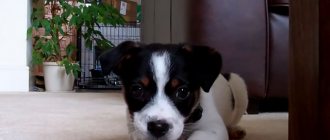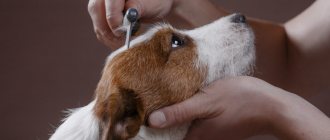The ears of a Jack Russell puppy serve as original sensors of his mood. They are distinguished by great mobility and at any moment allow you to notice the pet’s alertness, calmness, fear or joy. But they must always return to their original position, which is provided for by the breed standard. A special procedure is intended for this - gluing the ears.
Gluing Jack Russell Terrier ears
Correction of the ears of a small Russell is a special intervention, the purpose of which is to give them the correct shape, which is provided in the description of the exterior.
There are two ways to perform such an operation - mechanical and surgical.
Surgical correction can only be performed by a professional surgeon. They resort to it in the most difficult situations, when achieving the standard form in any other way turns out to be impossible.
Mechanical correction implies that the Jack Russell Terrier's ears are glued using a regular patch. This is a completely safe and painless method that quickly obtains the desired shape of the auricle.
When your Jack is less than 8 months old, and the shape of the ears deviates from the breed standard, but not critically, mechanical correction is definitely required.
Interesting Facts
- July 2 is Parson Russell Terrier Day. It was on July 2, 1999 that the IFF officially recognized the breed. Dog lovers and owners get together, hold competitions or simply celebrate together.
- Parson Terriers are the best high jumpers. The current breed record is a jump of 198 cm.
- Jack Russell was not only a lover of hunting, but also of horse riding. Therefore, another criterion for the new breed was the ability to quickly and tirelessly run after a horse. This breed is named among the top ten dogs that are the best long-distance running partners.
What causes a dog's ears to go up?
It is impossible to definitively answer why the Jack Russell's ears rise. There are many possible reasons for this, starting with the level of calcium in the body and nutrition in general, ending with natural changes at the age when teeth change, as well as vaccinations.
A terrier's ear misalignment can occur for many reasons. These include:
- increased concentration of calcium in the body;
- sudden age-related changes;
- vaccination;
- genetics (heredity).
If you have suspicions about excess calcium in the puppy’s body, it is better to contact a veterinarian. There they will conduct tests and only based on their results can a decision be made about the need to change the diet or stop taking vitamin supplements.
But still, the main factor is genetics. This breed of dog was bred specifically to help hunters drive foxes out of holes. For this reason, the “correct” ears were drooping, so they protected the shell well from dirt. Today, the Jack Russell breed has lost its real role - hunting. They are rarely used for their intended purpose. They almost completely became domestic animals rather than hunting animals. For this reason, more and more individuals are appearing with erect rather than drooping ears.
If one of the parents or both parents of a puppy of a given breed had such deviations, the reason for the irregular shape of his own ears is hereditary with a probability of almost 100%. But in order to accurately determine it and correctly solve the problem, it is advisable to consult a breeder who is well aware of the genetic characteristics of your dog. He will be able to offer the most effective, in a particular situation, way to correct the shape of the ears.
Strict breed standards have not been canceled. Full compliance with them is one of the most important criteria at dog shows. The Jack Russell Terrier must have properly set ears. If you want him to participate in exhibitions and not be disqualified, you need to pay attention to this at an early age (up to 9 months).
Sequencing
Before you start gluing your Jack Russell's ears, try to soften them with a massage. For several days, stretch the cartilage along the fold line.
Massage thoroughly until you feel that they have become elastic. After this, you can begin the procedure. And ask someone from your family to help - hold the puppy while you seal it .
So, prepare the necessary materials :
- plaster - it is best to use a regular adhesive plaster 2-3 cm wide;
- scissors, preferably medical, with rounded ends so as not to injure the animal;
- a five-ruble coin or a small weight.
First determine the desired fold line. To do this, take the ear by the tip and lower it to the outer corner of the eye so that it points down and forward. Don't pull too hard, just point it.
Jack Russell Terrier ear correction procedure
The ears of a Jack Russell puppy are glued with a medical plaster. It is important that it is quite wide and sticky. It is best to take it on a fabric base with a width of 2 centimeters. This allows you to securely fix the correct position. There are three correction methods using this material that allow you to give the Jack Russell ears the desired shape.
A few days before the procedure, you should regularly massage the shells of the ears in those places where the folds are supposed to be made. The massage must be thorough to ensure warming and softening of the ear cartilage; it must be done carefully so as not to cause pain to the animal. Perform this massage more often, at every opportunity. After 4 days of regular kneading of the folds, you can proceed directly to gluing the ears.
Optimal age for ear set correction
You shouldn't wait until your pet reaches adulthood. If during the period of teeth change (at 3-4 months) his ears become at least partially erect, start acting.
Three methods of ear gluing procedure
There are only three ways to correct the shape of the ears of this breed. None of them pose a risk to the dog's health. However, they also do not provide an absolute guarantee of results. Often, after gluing, the ears, having already acquired the desired shape, rise again.
Method No. 1 - for ears set close to a vertical position
If your puppy has vertical ears or they are close to this position, you will need to first determine where the fold should go.
To do this, take the tip of the ear with your fingers and try to bring it closer to the outer corner of the dog’s eye, while bending the ear cartilage. It is in this position that you need to fix the puppy's ear. To do this, cut a strip of tape, then stick it on the outside of the ear slightly below the fold line, parallel to it.
Next, you need to bend the edges of the patch, after which this procedure is repeated on the inside. Attach at least three layers of adhesive tape to provide sufficient weight to the ear. And it is advisable to glue a coin to its tip, which will act as a weight. It should be attached well so that it does not slip out during active movement.
Method number 2 - to fix broken lines
This method involves using less patch but requires more patience. If your ear is bent or bent in the wrong place, you must first straighten it. To do this, lift the sink and stick adhesive tape on the inside. It is necessary for the ear to take a vertical position. If this was not achieved, stick on a few more layers.
When it is possible to place the ear, it is necessary, similar to the first method, to determine the correct position of the auricle. To do this, lower the tip of the ear, then pull it to the outer edge of the eye. You will need to hold the dog in this position for 20 minutes. Given the Russells' energy, this will not be easy. Be patient.
After just 20 minutes, the auricle will find its correct position. If it rises again, this indicates that you have pasted more layers of adhesive than necessary. You just need to remove the excess and repeat all the steps to fix it.
Method No. 3 - general, enhanced
This method is suitable for puppies that most zealously resist attempts to glue their ears.
First, a patch is glued to the inside of both ears. It must be glued across, leaving a margin of 1-2 cm.
An assistant is needed to carry out this procedure. One person bends and holds the ears in the desired position, and the other at this time must take a solid piece of the plaster, then, starting from one ear, through the forehead to the second, carefully glue the dog’s head. The tips of both ears should be securely glued thanks to the additional “reserves” of adhesive tape remaining at the edges. After this, the patch needs to be extended further, gluing it in the place where the jaw and neck connect, and return to the first ear. At the end, the adhesive ring closes; securely fix the edges. The dog's head will be bandaged.
How to care for your bandage
After taping the ears in this way, the dog should wear the bandage for a week. Then, to prevent diaper rash, you need to remove it for 4 days. To prevent inflammation of the ear from the inside, it is advisable to put a piece of bandage under an adhesive bandage. After the “rest”, the whole process must be repeated with similar frequency until the ears acquire the correct shape. If diaper rash occurs, you need to treat it with salicylic alcohol.
Solution
Typically, the ear cartilages in puppies begin to rise after changing teeth, at three to four months of age. Once you have discovered this, it is time to sound the alarm. Do not hope that raised ears will go down on their own - immediately make every effort to correct them.
The deficiency can be eliminated in two ways: surgically and with the help of a patch. The first method is used in especially severe and advanced cases. This operation is carried out in veterinary clinics by experienced specialists, and we will not write about it.
The second method is to seal the ear cartilages with adhesive tape. It is completely safe, accessible to everyone and does not injure the animal. The bandage will smooth out unwanted folds on the ears and lower them down.
And do not forget to consult with your breeder first - he knows the genetic characteristics of your dog, and his advice will be valuable to you.
Useful tips and opinions from veterinarians
The tail plays an important role in animal communication. According to research by Canadian scientists on the behavioral reactions of dogs with changes in the tail, even the amplitude of its movements is an important signal. This is how animals determine whether to approach each other, what mood the opponent is in, and whether he poses a threat.
Doctors agree that docking a dog's tail is purely aesthetic. By deliberately injuring a pet, the owner reduces the possibility of conflict-free and meaningful communication.
When gluing the ears of a Jack Russell, it is important to ensure that diaper rash does not form on the skin. If they are found, remove the bandage and let your pet rest for a couple of days. It is advisable to wipe the inner surface with salicylic alcohol to stop the spread of bacteria.
Are there any contraindications?
There is no reason not to dock a Jack Russell's tail. But if the dog feels unwell, it is better to reschedule the operation. It is recommended to postpone the procedure when:
- the dog is drowsy, lethargic and lacks appetite;
- puffiness or swelling appears on the body;
- there is atypical discharge from the mucous membranes of the nose or eyes.
The only contraindication to docking is the age of the animal. The operation should not be performed on old dogs. The subcaudal artery, through which blood flows to the tip of the tail, is quite large. The older the dog, the more effort it will take to sew it up. And post-traumatic swelling increases the already strong tissue tension.
As a result, the risk of suture dehiscence and subsequent bleeding increases.
Choosing tail length
There is no concept of “standard tail length” for this breed. Previously it was believed that the classic size for the Jack Russell was 4 inches (10.6 cm). It is a myth. The optimal tail length depends on the size of the dog. The main thing is that it looks harmonious with the terrier's body.
To be fair, it is worth noting that a tail that is too short (when 4-5 cm does not fit on top of a clenched palm) is considered a disqualifying fault. Usually, when determining the cut-off line and predicting the size of an adult Jack Russell Terrier, breeders rely on the data of the parents.
At what age is the procedure performed?
Usually the operation is performed from the 3rd to the 10th day of the dog’s life. There are three reasons for this:
- At an early age, the sensitivity threshold is greatly reduced due to the small number of blood vessels and nerve endings in the limb.
- The puppy's tail bones are also soft, making docking easier.
- The healing process in a baby is faster than in an adult dog.
Cupping is also allowed at an older age, but no later than 6 months. At this time, the operation is painful, so anesthesia must be used. Also, the rehabilitation and healing period will be slower.
But the main risk when operating on an adult dog is anesthesia. Many dogs exhibit intolerance, and there is a high risk of cardiac, respiratory, and anaphylactic shock.
Postoperative period
Typically, tail docking is easy and without complications. Already on the second day after the procedure, the puppy is cheerful and active again. Adult dogs may become restless by licking the amputation site. But this does not in any way affect their usual daily schedule. There is no need to change the diet; the wound is a minor injury that heals quickly in dogs.
However, there is a risk of encountering some complications:
- Bleeding. The older the dog, the higher the risk. If the wound bleeds, it must be treated with streptocide or a 5% alcohol solution of iodine. It is also advisable to bandage the tip of the tail for 12-24 hours. An additional protection is provided by a collar that will prevent licking and removal of the medicine.
- Inflammation of the sutures. Occurs when sterility measures are not observed during cupping, sutures come apart, also when the dog’s immunity is low or the presence of subclinical infectious diseases. You can treat the inflammation area with iodine, but it is better to entrust the treatment to a specialist.
If complications arise, the surest way out is to consult a veterinarian. A specialist will always be able to determine the treatment method more accurately and correctly.
Is it safe?
Properly performed gluing does not cause any harm to the dog. However, if the owner does not have experience, it is better to entrust the first gluing to your breeder or another specialist who has experience working with this breed. Since the procedure is repeated many times during the change of teeth, over time the owner will learn to do it independently and the need for specialist intervention will disappear.
Some of the most common side effects and problems include:
- Allergy to the patch in a dog;
- Excessively tight ear;
- Fixation of ear position that does not correspond to the breed standard;
- The appearance of irritation and bacterial infections;
- Painful sensations caused by a patch or glue in the ear when they are removed.
Advice! At first, keep a close eye on your puppy. An attentive owner will promptly detect the appearance of a characteristic unpleasant odor, anxiety of the puppy, itching and redness. These symptoms are a sign of developing inflammation and require immediate removal of the patch and healing of the painful area.
How to choose the right puppy
Parson Russell Terrier puppies are practically no different from Jack Russell babies. Small dogs are identical until 9–12 months, when the difference in size and build becomes noticeable. Because of this similarity, inexperienced dog breeders purchase crossbreeds, and scammers easily pass off one breed as another.
Some prefer to take teenagers (6-7 months) in order to see external qualities, advantages and disadvantages, because by this age babies acquire the features of adult dogs.
In order not to make a mistake with your purchase, you need to contact the official breed nursery.
Unfortunately, in Russia there are few breeders involved in breeding Parsons; Jack Russells are more popular.
Important! All kids should be clean, active and healthy. Passivity, lack of reaction to a stranger is a pathological sign.
Tags
Jack Russell TerrierJack Russell TerriersJack Russell TerriersJack Russells.Jack Russell TerriersJack Russell TerriersJack Russells shouldJack Russell TerrierJack Russells stand upJack Russell Terriers The ears of dogs of this dog or the heads of a dog. Your dog can the ears of the dog the ears of the dog the desired ears of the dog the desired cause pain to the dog. In dogs usually many dog breeders are repelled by the Jack Russell breed. Jack's ears ears Jack Russell Jack Russell Jack Russell Jack Russell Since Jack Russell Jack Russell breed Jack Russell
read wool
Materials
There are several methods for gluing ears:
- Using a patch;
- Using glue;
- Using weighting objects;
- With the use of auxiliary devices.
Before putting your Chihuahua's ears on, it is important to check your dog for allergies. If the patch material is not suitable, other materials can be used. This is for example:
- Surgical breathable tape;
- Reinforced construction tape;
- Masking tape for painting cars. Breeders recommend Italian.
Alternative materials are less sticky, easier to remove and more rigid, but are not always available.
Jack has ears on the top of his head or how to glue ears correctly
Jack Russell Terriers are famous for their unusually emotional facial expressions, which convey all the feelings of your pet. And the neat ears of dogs of this breed play an important role in conveying their mood.
By the position of the ears, you can determine whether your dog is happy or sad, listening carefully or scared.
There are certain requirements for the placement of the ears of Jack Russell Terriers at exhibitions when assessing the exterior. Therefore, if you want your pet to receive high marks at exhibitions and also be allowed for breeding, you should take care of the correct placement of Jack Russell ears.
Vaccinations and susceptibility to disease
Vaccination is the only method of preventing dangerous viral diseases that the dog’s immune system is not able to cope with. Vaccination begins early, at 2.5 months. Then the puppy is injected with strains of distemper, enteritis, hepatitis, and parainfluenza. After 2-3 weeks, the vaccination is repeated, adding leptospirosis.
At 6–7 months they are vaccinated against rabies. All vaccinations are repeated annually to prolong the effect of the drug.
The Parson Russell Terrier breed is considered one of the healthiest dogs in the world. She does not have heart or gastrointestinal problems or neurological spectrum disorders. But dogs are not without genetic diseases.
The main problem is necrosis of the femoral head. It appears by the age of 5–6 years. The common name of the disease is Legg-Peters disease.
Congenital deafness is less common. It is typical for individuals with a pure white coat color.
Important! A congenital disease that can be seen in puppies is a lack of coordination of movements. It is incurable and is characterized by disorientation in space and chaotic movements.
Correct form
In the twentieth century, breeders began to pay special attention to the ears of Jack Russell Terriers. In order to prevent soil from getting into the dog’s ears during burrow hunting, they must be semi-erect, that is, slightly raised on the ear cartilage. When excited, the dog can turn them one hundred and eighty degrees.
In a state of calm, the pet's ears are in their normal position - they hang straight forward and fit tightly to the head, and their ends point straight down. Each dog's ear has only one fold - a fold line, which should not be lower than the level of the head.











